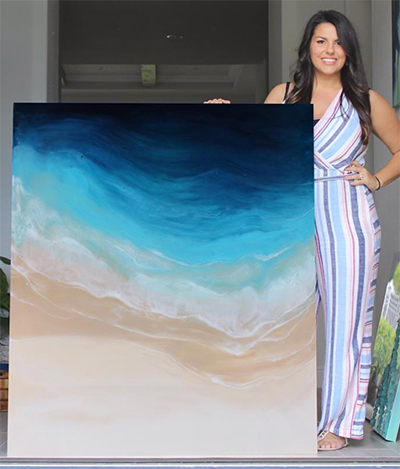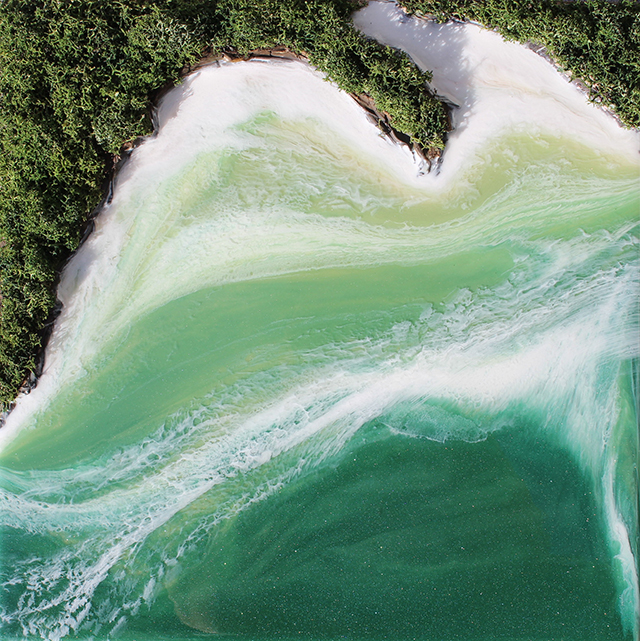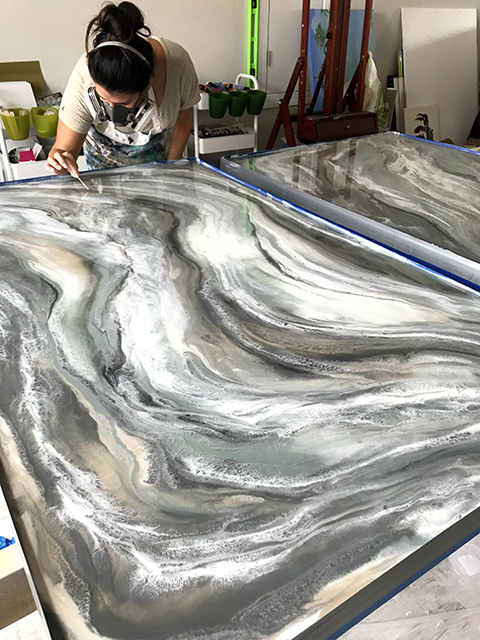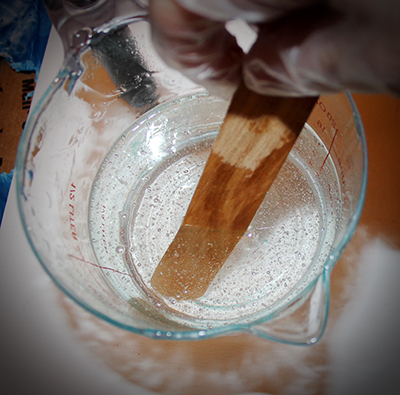Picture yourself in a plane descending toward the Fort Myers airport, zooming over the barrier islands and coastline of Southwest Florida. Nose nearly pressed to the window, you peer down at emerald and azure waters with foam-capped waves lapping up against sandy shores, imagining you could trail your hand or dip your toe in the shimmering, undulating tides.

That’s the sensation Alexis Martinez Puleio (’09, Biology and Chemistry) aims for and captures in aerial seascape paintings rendered in acrylics and epoxy resin. But you can actually reach out and touch this FGCU alumna’s artwork — unlike most paintings, which are meant to be admired at arm’s length. In fact, Puleio encourages clients to run their fingertips over the glassy surface of her bird’s-eye-view images, which sometimes are embedded with handmade rocks and greenery to create a tactile, topographical representation of a natural shoreline.
Puleio’s unique technique, artistic gift and loving eye for sand and sea — an admiration shared by Southwest Florida residents and envied by visitors — has driven the success of this 33-year-old artist, who didn’t even major in art at Florida Gulf Coast University. Her inviting creations are sold through upscale channels at The Ritz-Carlton Resort of Naples and The Eydel Fine Arts Gallery in Naples, as well as on her website. They’ve also caught the eye of publications such as Florida Design, The Scout Guide and TimeOut Polk.
“What started as a hobby, as a means for a creative outlet, has grown into a full-blown business,” says the busy mother of two. “We lived in a condo when I was starting out, and I took over every square inch of table space I could find to work. I flooded our kitchen, living room and dining room with art.”

Working in oils, acrylics and watercolors, in abstraction as well as realism, she took commissions small and large for wedding-dress paintings for brides, orchid still lifes, marine life imagery and architectural landscapes. The turning point came in 2016 with a monthlong solo show at Polk State College in Winter Haven, Florida.
“From there, the doors of opportunity opened,” Puleio says. “Word of my art spread, and I landed the job of a lifetime creating four oversized (10-feet by-5 feet) paintings for the new Carol Jenkins Barnett Pavilion For Women and Children” at Lakeland Regional Health in Lakeland, Florida. I am truly grateful for every door that has opened up for me in my art career, and hope that they continue to open as I grow as an artist.”
As her business flourished, so did her family with husband Vincenzo “Vinny” Puleio, owner and operator of Enzo’s Italian Restaurant in Bonita Springs. They now have a 7-year-old daughter, Giuliana, and a 9-month-old-boy, Sebastian, as well as a home with an upstairs studio so she can have her own workspace but still be home with the children.

“I create every day in my studio, whether it’s only for an hour or for 5-plus hours,” Puleio says. “It can be challenging at times, with my second-grade daughter doing school from home virtually this past year because of the pandemic, and with a new baby in the house. But I make sure to devote a portion of my day to creating. Not only is it good for business, but it’s good for the mind as well.”
In addition to wall-enhancing artwork, she produces functional home items such as serving trays and charcuterie boards, and jewelry for men and women featuring smaller-scale evocations of her aerial seascapes. Her inspiration often comes from actual shorelines, bays and waterways but her imagination and technique help her visualize her own perspective.
Growing up in Lakeland, Florida, Puleio visited Anna Maria Island every year with her family, then fell in love with Naples when she moved to Southwest Florida for college.
“There is something about the warm Gulf waters that can renew your soul,” she says. “Outside of Florida, Hawaii is by far my most favorite location.”

Taking advanced art classes in high school, she was nurtured by teachers and parents who encouraged her to pursue her creative talents. Intending to go on to medical school to become a surgeon, she enrolled at FGCU on a pre-med track, but was able to take a couple of art classes taught by the late Carl Schwartz. During her senior year, she met her now-husband.
“I was swept off my feet,” she says. “I decided to put medical school on hold, and I am so very happy that I did. We have a beautiful, fun and full life together. I get to spend every day doing my true passion in life — creating a piece of me that gets to stay on this earth, even after my lifetime has passed by.”
So, instead of wielding a scalpel, her nimble fingers hold sketch pencils and paint brushes.
Following favorite drone accounts on social media, she puts ideas together in a sketch book, then draws out her plan on canvas before painting in acrylics and tinted resin.

“As the years have gone by, my art process has become second nature,” Puleio says. “It’s more based on my imagination and how I am feeling in the moment. I ask myself: Do I want the water to look cold and dark? Do I want warm tropical waters? What about the sand? Textured or smooth? Are the waters going to be rough or calm? If the piece is for a collector, I gear these questions towards them to help myself envision what they see.”
With tools or gloved hands massaging the canvas, she spreads the resin — a clear, honey-like substance that when mixed with a hardener creates a glass-like topcoat and sheen that protects the painting. Using a small blowtorch, she can move sections of curing resin to create a watery effect.
“The high-gloss shine, with its reflective surface, gives your art a wow factor that you can’t get with paints alone,” she says.
Resin is a petroleum-based product, and the brand Puleio uses, ArtResin, is non-toxic, free of volatile organic compounds and certified food-grade safe (for the serving trays and boards).

“These are important factors for me, with my studio being in our home,” Puleio says. “The very first time I used resin was after searching for a product to protect one of my orchid oil paintings. I wanted something to give it a high shine. That’s when I discovered resin. After using it that very first time, I was hooked. I wanted to find new ways to apply it and manipulate it in new creative ways. At the time when I was doing my research, not many people had experimented with adding color to their resin art. Therefore, trial and error was the only way to learn.”
One downside: The artist has to plan ahead — and then surrender control. Once the hardener and the resin have been mixed together, she has 45 minutes to manipulate it before it starts to become tacky and solidifies. Color additives have to be premeasured, tools must be handy and a pouring strategy considered. Once the process begins, any distraction in the studio could mar the outcome.
Resin is self-leveling and moves around the surface for hours before it settles and starts to cure in place — sort of like sand washing up on a tide and settling on a beach. Not knowing how the coating will land adds a layer of chance and excitement to the artist’s vision.
“It’s a process where you have to relinquish your need to control, which is both restrictive and freeing at the same time,” Puleio says. “I can control my ideas, and my vision, the placement of the rocks, or greenery, and I can plan where I want the resin to go, but where I lose control is where the resin ends up. You have to have faith in your process, your knowledge of the medium, and hope for the best. I love trying to get a realistic aerial aspect in my paintings, but it is nice to just pour and see what happens as well.”